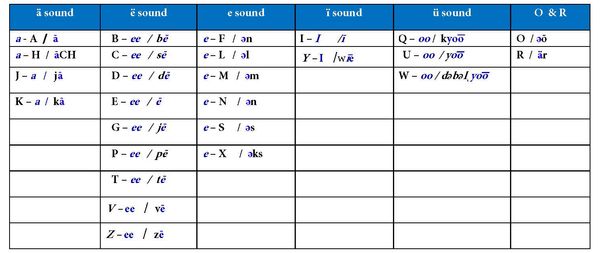0

The ABCs, English Pronunciation's Foundation
vor 3 JahrenThe ABCs, English Pronunciation's Foundation

Do you know that the English alphabet serves two distinctly different functions?
Allow me to make my case.
Alphabet Letters, Letter Names, & Alphabet Sounds
You, I, and everything have a name; alphabet letters also have names. We have all learned to call the group of 26 alphabet letters the ABCs. We also know the names of the 26 English alphabet letters: A, B,C,D,E,F,G,H,I,J,K,L,M,N,O,P,Q,R,S,T,U,V,W,X,Y,Z.
Now, here is where the confusion begins. Many believe that knowing the names of the English alphabet letters is all they need to understand for reading, writing, and speaking English. Far from reality, this thinking becomes the stumbling block between your and English pronunciation perfection.
American English Alphabet letters are Written and Read.
When reading and writing the function of the 26 English Alphabet letters is expressing and comprehending word meanings.
American English Sounds are Spoken and Heard.
The same 26 American English Alphabet letters in various combinations within words also represent the 44 English sounds for speaking English.
The logic and principles for reading and writing the 26 Alphabet letters are not the same as in spoken English.
Let’s build your English pronunciation foundation.
We will start with understanding Alphabet letter names and the Alphabet letter name groups.
American English Letter Names and Name Groups
Before we examine the list of the 44 English sounds, I want you to understand a little bit of the English sound concepts of English Alphabet letter names and Alphabet letter name groups.
Stay with me! Yes, you learned the ABCs as a child, but do not be arrogant and stifle your English pronunciation progress. At about the same age, you learned to count to ten - algebra, geometry, and trigonometry required you to build upon that learning.
The American English Alphabet
The American English Alphabet has 26 Letters.
A, B,C,D,E,F,G,H,I,J,K,L,M,N,O,P,Q,R,S,T,U,V,W,X,Y,Z
Each Letter of the American Alphabet has a name if you know your ABCs, you know the Alphabet names.
Each letter of the American Alphabet also has at least one sound (some have more).
There are 5 Vowels in American English.
A, E, I, O, U (Y, sometimes!)
Each of the five vowel letters can represent at least three sounds, a long sound, a short sound, and a schwa.
Some of the five vowels represent more than three sounds.
There are 21 American English Consonants.
B,C,D,F,G,H,J,K,L,M,N,P,Q,R,S,T,V,W,X,Y,Z
A consonant letter usually represents one consonant sound. Some consonant letters, for example, c, g, s, can represent two or three different consonant sounds.
The letters q, x, and z also have more than one sound.
Some of the American Alphabet letter names like [Q-oo], [W-oo], and [e-X] have little relation to the English spoken sound. They are just the Names of the Alphabet letters.
Letter Name Sound Groups
The 26 American English letters divide into five letter sound groups. Letter sound group members have the same sound at the beginning or the end of the letter name. Understanding letter sound groups will help you understand diphthongs and vowel glides in a later section of the workbook.
Look at the letter sound groups in the table below. Notice how the letters in each sound column all have the same sound; the letter sounds rhyme. Note that a sound comes before or after the letter sound - for example, the letter [J] is pronounced [j-ā ].
Do you see that the names of the alphabet letters include the principal sound the letter name represents - not forgetting that some of the letters represent more than a single sound?

The letters names [b,c,d,g,p,t,v, and z] first make the representative plosive sound followed by the long [ē] vowel sound.
Consonant plosive [b,d,p...] and fricative [c,s...] sounds - can only be fully voiced when followed by a vowel. Try yelling for help using this letter combination - HLP.
We will practice pronouncing the 26 alphabet letter names using the table below.
Start at the top of each of the six columns and work your way down each row. Be sure to loudly and clearly articulate each of the two sounds of each letter name. Note that [w] has three sounds [də bəl yo͞o].
Now, you will hear those letters which have similar sounds grouped:
In the first group, there are the letters that sound like the word “age”:
A, H, J, K
The letters in the second group sound like the “ee” in the word “see”:
B, C, D, E, G, P, T, V.
The letters in the third group sound like the “e” in the word ten:
F, L, M, N, S, X.
The letters in the fourth group sound like the “i” in the word “drive”:
I, Y.
Then there is the letter O as in the word “home”.
In the next group, the letters sound like “oo” in the word “too”:
Q, U, W.
The letter [r], which sounds like the [r] in the word [car], [bar], and [scar], stands alone, as does the letter “O.” The letter names O and R have their sound and do not belong to a sound[group.
It is helpful to understand the letter names and their groups, the 1st step in learning to pronounce the letter sounds within words.
Listen to Mentor Josephan enunciate the letter names; you will clearly distinguish the letter names and the sounds they represent.
This concludes The Foundation of English Pronunciation Part I
Subscribe to English Pronunciation Foundations to receive MJ’s Blog updates, Teacher’s Bookshop discount coupons and more.
The above English pronunciation lesson is part of
Mentor Josephan's
5-Lesson English Pronunciation Workshop. Enroll Now and get started perfecting your English pronunciation.
